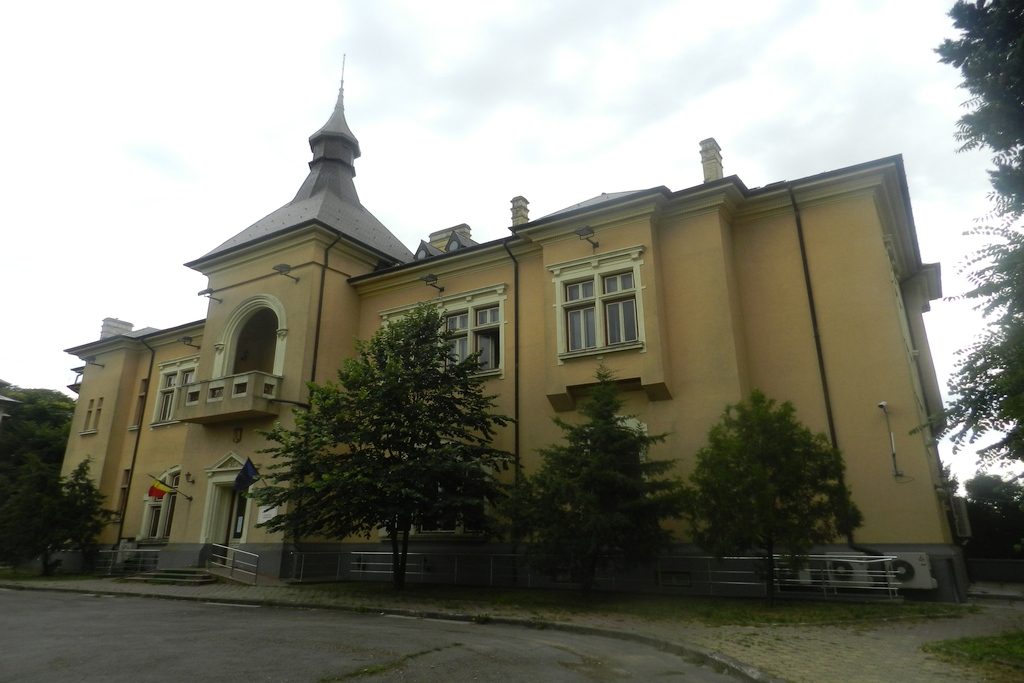

The Royal Palace from Constanța was the first royal residence from the Black Sea and the construction started in the year 1902, being finalized in 1906.
The palace of Carol I is developed on basement, ground floor, first floor and mansard. At the windows and at the doors there are noticed even in the present the good profiled frameworks. The principal access in the Palace is marked by a gazebo; in the central ax of the building it is equipped with a balcony. The austere style has been demanded by the king and adopted by the designers, the specific elements of the exterior decorations being few. Initially, the principal façade was facing a small market, beautifully arranged with cubic granite stone, flowers and ornamental shrubs and, moreover, towards the old building of the train station built by the British. The southern façade of the Royal Palace has two long terraces, closed with metallic woodwork made of wrought iron which announces the astonishing style Art Nouveau. Another entrance in the building, the Eastern one, is also marked by a hallway specific to Neo-Romanian.
In the interior, beautiful fresco in oil decorated the official receiving saloons, the spacious reception room and few of the working rooms of the king. The magnificent receptions constituted the delight of the conventional world and of the local elites and for the sovereign were a method of investigating the attachment for the Crown and for its politics.
From here, from the Royal Palace from Constanța, Carol I frequently followed the pompous preparations for the inauguration of the Lighthouse which bears his name, one of the most modern from Europe at that given time but, more certain, he lived moments from the adventure of the terrestrial offensive of the Romanian army in Bulgaria, in the summer of the year 1913 and tasted the sublime of reuniting Dobrogea. Because, in August 1913, the Kingdom was enlarging with two more counties, Caliacra and Durostor, the province between the Danube and the Sea being the first one which found its full unity. The reception which celebrated that historical moment remained for a long time embeded in the mind of a world which started to move feverishly and which smelled, more and more obvious, of war.
The Royal Palace from Constanța, didn’t live, as an official residence, only for a decade. The last royal summer of the Palace was exactly before the one of June 1916, a few days and a few weeks before the ending of the peace and the starting of the war. In October 1916, after the occupation of Dobrogea by the German, Bulgarian and Ottoman troops, the Royal Palace from Constanța became the official residence of the German military administration of the province. When the Germans left from the Palace, in the fall of the year 1918, it is said that it died, in some way also the royal history of the building. In 1922, officially King Ferdinand and Queen Maria gave up the Royal Palace from Constanța, the immobile entering into the administration of the Ministry of Justice. In exchange of two million RON, the royal family agreed that, in 1924, here to be opened the county Court. The entering of Romania in the Second World War changed again the destination of the former royal residence. The administrative head office of the Romanian military commandment from the summer of the year 1941, the immobile is brought into requisition in September 1944 by the Red Army which will administer it until the departure from 1958. Projection shop, House of the Pioneers and storage of the Art Museum, starting with 1977, are only a few of the destinations of the Royal palace, which fell more and more in disgrace, destruction and forgetfulness. In March 1990, by the means of a decision of the City Hall from Constanța, the former residence of King Carol I and of Queen Elisabeth received, once again, the destination of head office of the Court.
